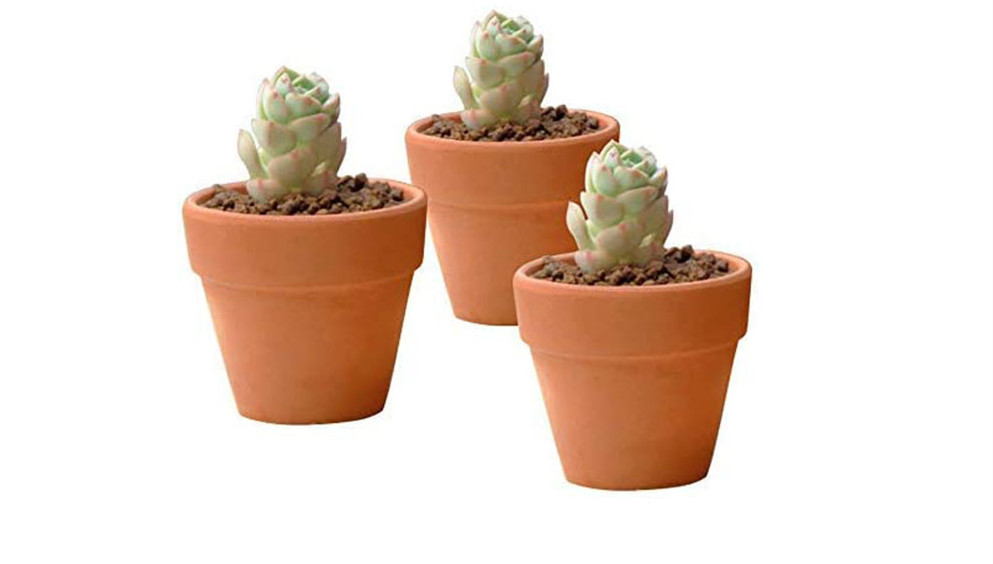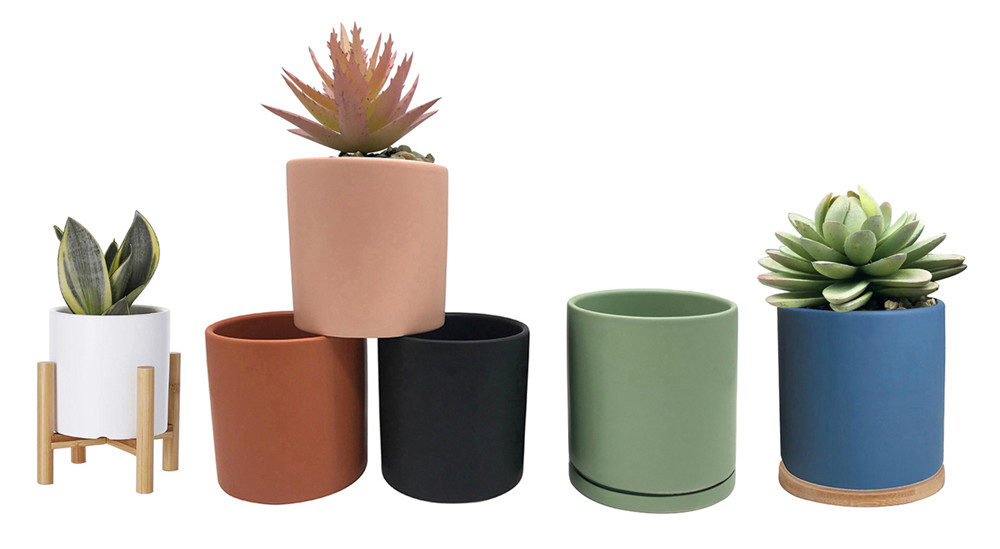Fioriera in terracotta vs fioriera in ceramica: ultime analisi del 2024
Ora di emissione: 2024-01-15 14:41:52
Quando si vogliono coltivare piante, la prima cosa da considerare è dove posizionare i vasi, all'interno o all'esterno, sul pavimento o su un tavolo. La maggior parte dei vasi in terracotta viene utilizzata all'esterno, mentre i vasi in ceramica sono più comunemente usati all'interno. Ci sono delle ragioni per questo. Vediamo perché la maggior parte delle persone usa questo metodo. Ma a un certo punto, si cerca un vaso resistente e bello. Questo non dimostra che si è antiquati, ma che si è persone che tengono conto delle risorse.
Le fioriere in ceramica hanno certamente un aspetto accattivante e moderno, ma la domanda sorge spontanea: sono fatte per durare? D'altra parte, i vasi in terracotta potrebbero non sempre catturare l'attenzione con il loro aspetto un po' semplice e a volte poco attraente. Tuttavia, è importante notare che, indipendentemente dalla scelta tra ceramica e terracotta, entrambi i materiali presentano una serie di pro e contro che richiedono un'attenta valutazione prima dell'acquisto. In questo blog, approfondiremo il mondo dei vasi in terracotta e in ceramica, esplorandone le caratteristiche e aiutandovi a determinare quale materiale si adatti meglio a diversi scenari di giardinaggio.
Vasi di terracotta

Secondo un rapporto di howstuffworks . Dal latino "terra cotta", il termine terracotta è in uso dal XVIII secolo. La pratica di cuocere l'argilla è nota da molto prima. Se avete bisogno di prove, chiedete all'esercito di soldati di terracotta della Cina nord-occidentale, realizzato più di 2.000 anni fa. Oppure considerate la Venere di Dolni Vestonice, la più antica scultura in terracotta conosciuta, risalente al 26.000-24.000 a.C.
"Il termine terracotta si riferisce a una ceramica porosa, cotta a bassa temperatura, utilizzata da millenni", spiega Sarah Barack, responsabile della conservazione e restauratrice senior di oggetti presso il Cooper Hewitt dello Smithsonian Design Museum, in una dichiarazione via email. "In genere ha un colore rossastro o rosa dovuto al ferro contenuto nell'argilla, che si ossida durante la cottura."
Essendo un materiale poroso, permette all'aria di passare, evitando problemi come il marciume radicale. Può anche aiutare a drenare l'umidità in caso di annaffiature eccessive. Tuttavia, ha anche uno svantaggio. A volte, la terracotta assorbe tutta l'acqua. Per evitare che ciò accada, puoi tenere il vaso di terracotta nel lavandino pieno d'acqua per tutta la notte. Quando lo utilizzerai, solo il terriccio assorbirà l'acqua. Puoi migliorare questa stagione tenendo un vaso di terracotta per fiori come ricordo dell'autunno.
I vasi in terracotta sono utilizzati da secoli e sono apprezzati da giardinieri e amanti delle piante per diversi motivi:
1. Porosità
Terracotta is a porous material which allows air and water to pass through the pot and reach the plant's roots. The high water permeability rate ensures that excess water in the flower pot can be drained out of the flower pot. Do not let the roots soak in water.
This is also the reason why terracotta flower pots are more suitable for outdoor use. Even with the tray there was nothing to stop the water from flowing everywhere. This promotes healthy root growth and helps prevent waterlogging or overwatering.
2. Breathability
Terracotta planters have a special quality called "breathability." This characteristic is closely tied to the porous nature of terracotta, a type of clay that allows air to flow through the walls of the pot. The term "breathability" describes the pot's ability to enable the exchange of air between the external environment and the soil inside the planter.
The breathability of terracotta plant pot is incredibly beneficial for the health of your plants. It ensures that oxygen can easily reach the roots of your plants, which in turn encourages robust and healthy growth. Moreover, it prevents the soil from becoming too densely packed, a condition that can impede the development of the roots.
This feature proves especially advantageous in preventing problems like root rot, as it assists in maintaining proper aeration and drainage within the planter. In essence, terracotta flower pot become natural allies to your plants, guaranteeing that they receive the essential oxygen and airflow required for their overall well-being.
Terracotta pots provide some insulation for the plants. The clay material helps regulate temperature, keeping the roots cooler in hot weather and providing some protection against temperature fluctuations.
3. Durability
Terracotta planters are not just famous for their breathability; they also boast remarkable durability, a quality that significantly contributes to their popularity among gardeners.
This durability stems from the fact that terracotta planters are crafted from clay that undergoes high-temperature firing during the manufacturing process. This firing process results in a robust and sturdy material capable of withstanding various environmental conditions and the test of time.
However, it's worth noting that while terracotta planters generally excel in durability, they can be vulnerable to cracking in extremely cold temperatures. Therefore, it's advisable to take precautions, such as protecting them during freezing weather.
4. Affordable
Terracotta pots are more cheaper than those made from other materials like ceramic or plastic.
Ceramic Pots

According to the history of ceramic development. Throughout the 16th century CE (CE = Common Era), earthenware remained the main class of ceramic products manufactured in Europe and the Middle East. The Chinese were the first to introduce high temperature kilns capable of reaching up to 1350 degrees, and, around 600 CE, developed porcelain (a material with less than 1% porosity) from kaolin clay. During the Middle Ages, trade through the Silk Road allowed for the introduction and diffusion of porcelain throughout Islamic countries first and later in Europe, due in large part to the journeys of Marco Polo.
Ceramic flower pots are a popular choice for both indoor and outdoor gardening. They come in a wide range of sizes, shapes, and designs, making it easy to find the perfect pot to match different types of plants and your personal aesthetic preferences.
One of the appealing aspects of ceramic flower pots is their natural look and feel. Many gardeners appreciate the authenticity they bring to their gardening spaces, as ceramic pots can mimic the appearance of natural materials.
The elegance and durability of ceramic vases also make them a highly recommended option. Their graceful designs add a touch of sophistication to any garden or indoor space, while their robust construction ensures they can withstand the test of time, offering a reliable container for cherished plants.
Although ceramics are not as old as terracotta, they are still several centuries old and are very popular with gardeners and plant lovers for the following reasons:
1. Durability
Ceramic planters are celebrated for their outstanding durability. The planter crucial step in their production involves subjecting them to high temperatures. This temperature is higher than terracotta. This process yields a robust and tough material that can withstand various challenges.
What sets ceramic planters apart is their exceptional resistance to weathering and fading. This quality makes them an exceptional choice for both indoor and outdoor gardening. Come rain or shine, exposure to sunlight, or fluctuating temperatures, ceramic planters remain steadfast. They keep their structural integrity intact and retain their visual appeal. Ceramic flower pots have better cold tolerance than terracotta pots and can withstand lower temperatures
Nevertheless, it's worth bearing in mind that ceramic planters, despite their resilience, do have a potential vulnerability. They can be somewhat brittle, which means they might chip or crack if subjected to heavy impacts or accidental drops. So, while they are incredibly durable in most respects, a certain degree of care is advisable to keep them looking their best.
2. Aesthetic Appeal
- Diversi design : le fioriere in ceramica sono disponibili in un'ampia gamma di dimensioni, forme e design. Che tu preferisca lo stile classico o quello contemporaneo, puoi facilmente trovare un vaso in ceramica che si adatti ai tuoi gusti e si abbini al tuo arredamento.
- Fascino visivo : la bellezza naturale dell'argilla, unita alla creatività artigianale degli artigiani ceramisti, dà vita a vasi che emanano un fascino visivo ineguagliabile. Spesso presentano motivi intricati, texture e smalti vivaci che catturano l'attenzione e aggiungono carattere a qualsiasi ambiente.
- Versatilità : i vasi da fiori in ceramica sono incredibilmente versatili. La loro versatilità permette loro di adattarsi perfettamente a diversi stili di giardinaggio o decorazione, dal rustico e tradizionale al moderno ed eclettico.
- Texture e finitura : le fioriere in ceramica sono disponibili in diverse texture e finiture, come superfici lucide, opache o texturizzate. Queste opzioni ti permettono di scegliere una fioriera per piante grasse che si adatti alle tue preferenze di design.
- Aspetto e sensazione naturali : molti giardinieri e decoratori apprezzano le fioriere in ceramica per la loro capacità di imitare l'aspetto e la consistenza di materiali naturali come la pietra o la terracotta, aggiungendo un tocco autentico al tuo spazio.
3. Ritenzione di umidità
I vasi in ceramica sono eccellenti nel trattenere l'umidità. Poiché la temperatura di cottura dei vasi in ceramica è molto più alta rispetto a quella dei vasi in terracotta, il loro tasso di permeabilità all'acqua è molto inferiore rispetto a quello dei vasi in terracotta, e l'acqua può essere conservata al loro interno. Questo elimina la necessità di annaffiare frequentemente le piante, il che è particolarmente vantaggioso per le piante che richiedono un ambiente più umido.
Facilità di manutenzione: la manutenzione dei vasi in ceramica è relativamente semplice. Possono essere puliti regolarmente con acqua e sapone per rimuovere sporco e detriti. Tuttavia, è necessario fare attenzione a non graffiare o danneggiare la superficie del vaso durante la pulizia.
4. Personalizzazione
- Smalti e finiture : i vasi in ceramica sono disponibili in un'ampia varietà di smalti e finiture. È possibile scegliere tra superfici lucide, opache o texturizzate, ognuna delle quali offre un effetto visivo unico. Queste opzioni consentono di abbinare l'aspetto del vaso al proprio arredamento o di creare un tema estetico specifico.
- Dimensioni e forme : le fioriere in ceramica sono disponibili in un assortimento di dimensioni e forme, dai piccoli vasi rotondi alle grandi fioriere rettangolari. Questa versatilità ti consente di scegliere le fioriere che si adattano perfettamente allo spazio che hai in mente e soddisfano le esigenze di crescita delle tue piante.
- Disegni e motivi : molti vasi in ceramica presentano disegni e motivi intricati che possono essere personalizzati in base ai vostri gusti. Potete optare per vasi con motivi artistici, forme geometriche o persino richiedere disegni personalizzati per rendere il vostro vaso davvero unico.
- Colori : le fioriere in ceramica sono disponibili in un'ampia gamma di colori. Che preferiate tonalità vivaci o tonalità tenui, potete trovare o richiedere il colore che meglio si adatta al vostro arredamento.
- Personalizzazione : alcuni produttori di fioriere in ceramica offrono opzioni di personalizzazione. Puoi far incidere o dipingere il tuo nome, un messaggio speciale o un logo personalizzato sulla superficie della fioriera, aggiungendo un tocco personale e significativo al tuo giardino o spazio.
- Pezzi complementari : puoi anche scegliere pezzi complementari in ceramica, come sottovasi, vassoi o elementi decorativi coordinati con la tua fioriera, creando un insieme coerente e visivamente accattivante.
Conclusione
In generale, i vasi in terracotta sono ampiamente apprezzati da molti giardinieri perché possiedono un fascino naturale e senza tempo e offrono anche diversi vantaggi per la salute delle piante. Il loro fascino classico ha resistito alla prova del tempo e la loro natura porosa favorisce le radici delle piante.
D'altra parte, i vasi in ceramica offrono funzionalità e bellezza agli interni, rendendoli una scelta popolare per il giardinaggio, sia in casa che all'aperto. Sono eccellenti nel regolare i livelli di umidità, garantendo alle piante la giusta quantità di idratazione. Inoltre, i vasi in ceramica vantano una lunga durata e sono disponibili in un'ampia gamma di design accattivanti, consentendo di valorizzare l'estetica delle piante e, al contempo, di fornire loro un ambiente di crescita sano e nutriente.
POST RECENTI
- I vantaggi dei prodotti ceramici all ingrosso di alta qualità per i rivenditori
2025-12-17
- Puoi realizzare un posacenere con argilla essiccata all aria
2025-12-17
- L'impatto dei materiali ceramici negli edifici ad alta efficienza energetica
2025-12-04
- I 7 principali benefici per la salute delle pentole in ceramica
2025-12-04
- Come pulire i vasi in ceramica e prolungarne la durata?
2025-11-17
- Le 15 migliori idee regalo in ceramica per le feste del 2025: premurose, eleganti e sentite
2025-11-17
- Gres vs Porcellana vs Terracotta: Guida Rapida alla Decisione
2025-10-09
- Gli smalti ceramici sono sicuri per gli alimenti? La verità dietro la lucentezza
2025-10-09
Hai bisogno di un preventivo?Hai domande?
Ricevi una risposta da un esperto entro 24 ore
PARLA CON UNO SPECIALISTA >









